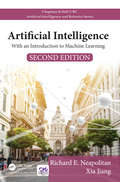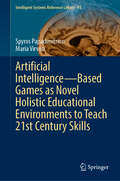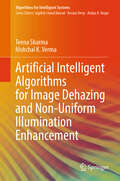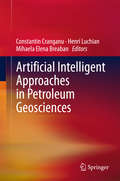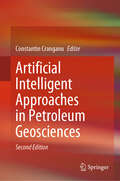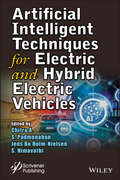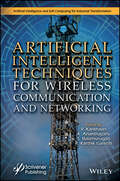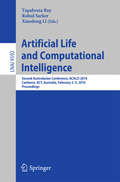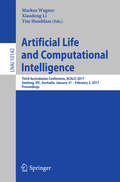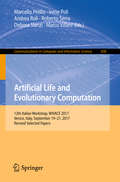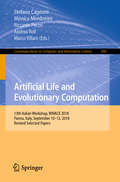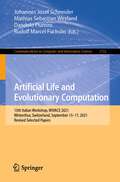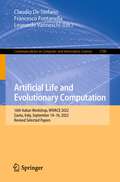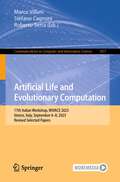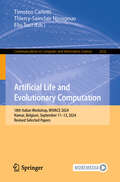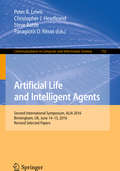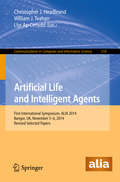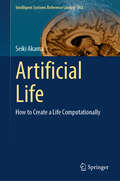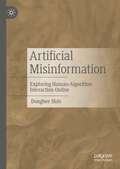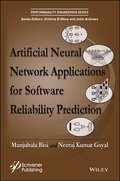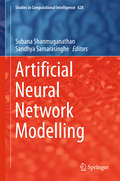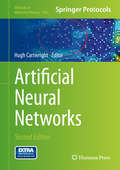- Table View
- List View
Artificial Intelligence: With an Introduction to Machine Learning (Second Edition) (Chapman & Hall/CRC Artificial Intelligence and Robotics Series)
by Richard E. Neapolitan Xia JiangThe first edition of this popular textbook, Contemporary Artificial Intelligence, provided an accessible and student friendly introduction to AI. This fully revised and expanded update, Artificial Intelligence: With an Introduction to Machine Learning, Second Edition, retains the same accessibility and problem-solving approach, while providing new material and methods. The book is divided into five sections that focus on the most useful techniques that have emerged from AI. The first section of the book covers logic-based methods, while the second section focuses on probability-based methods. Emergent intelligence is featured in the third section and explores evolutionary computation and methods based on swarm intelligence. The newest section comes next and provides a detailed overview of neural networks and deep learning. The final section of the book focuses on natural language understanding. Suitable for undergraduate and beginning graduate students, this class-tested textbook provides students and other readers with key AI methods and algorithms for solving challenging problems involving systems that behave intelligently in specialized domains such as medical and software diagnostics, financial decision making, speech and text recognition, genetic analysis, and more.
Artificial Intelligence—Based Games as Novel Holistic Educational Environments to Teach 21st Century Skills (Intelligent Systems Reference Library #93)
by Maria Virvou Spyros PapadimitriouThis book offers a visionary look at how AI can promote learning for modern skillsets by examining the fusion of AI, prosocial gaming, personalisation, ethics, and education. The book introduces the EPATHLO Suite, a novel AI platform that personalises both educational content and gameplay, creating tailor-made learning experiences and entertainment for each student. By blending personalised games with education, these AI-driven environments make learning more dynamic and enjoyable, while focusing on prosocial behaviour development, encouraging cooperation, empathy, and ethical understanding. It also provides roles for human teachers, as content creators of the EPATHLO Suite authoring tool. The book highlights the importance of twenty-first-century skills—such as critical thinking, collaboration, communication, and creativity—while also addressing ethical issues like data privacy (including GDPR compliance). It provides practical AI-driven solutions and reviews relevant literature, offering a comprehensive understanding of these interconnected fields. This book is an indispensable resource for those looking to explore these state-of-the-art topics. It is ideal for academics, researchers, students, educators, game designers, programmers, and professionals in the educational gaming industry who want to understand AI's role in shaping the future of education with games. Whether readers aim to enhance their classroom, develop new learning technologies, or better grasp the evolving technology of educational games with AI, this book offers valuable knowledge and practical tools for success.
Artificial Intelligent Algorithms for Image Dehazing and Non-Uniform Illumination Enhancement (Algorithms for Intelligent Systems)
by Nishchal K. Verma Teena SharmaThis book offers a detailed insight of artificial intelligence (AI) algorithms for image dehazing and non-uniform illumination enhancement. In this book, various image enhancement techniques under hazy and non-uniform illumination conditions are discussed. The book specifically provides a detail on how to approach image enhancement under different outdoor conditions using AI tools. The biggest benefit a reader would accrue is to get exposed to the various aspects one should take care of while working with digital images. The book also includes multiple inventions which were recently introduced by the authors for image enhancement and reviews the state of the art in respective subject matters.
Artificial Intelligent Approaches in Petroleum Geosciences
by Constantin Cranganu Henri Luchian Mihaela Elena BreabanThis book presents several intelligent approaches for tackling and solving challenging practical problems facing those in the petroleum geosciences and petroleum industry. Written by experienced academics, this book offers state-of-the-art working examples and provides the reader with exposure to the latest developments in the field of intelligent methods applied to oil and gas research, exploration and production. It also analyzes the strengths and weaknesses of each method presented using benchmarking, whilst also emphasizing essential parameters such as robustness, accuracy, speed of convergence, computer time, overlearning and the role of normalization. The intelligent approaches presented include artificial neural networks, fuzzy logic, active learning method, genetic algorithms and support vector machines, amongst others. Integration, handling data of immense size and uncertainty, and dealing with risk management are among crucial issues in petroleum geosciences. The problems we have to solve in this domain are becoming too complex to rely on a single discipline for effective solutions and the costs associated with poor predictions (e. g. dry holes) increase. Therefore, there is a need to establish a new approach aimed at proper integration of disciplines (such as petroleum engineering, geology, geophysics and geochemistry), data fusion, risk reduction and uncertainty management. These intelligent techniques can be used for uncertainty analysis, risk assessment, data fusion and mining, data analysis and interpretation, and knowledge discovery, from diverse data such as 3-D seismic, geological data, well logging, and production data. This book is intended for petroleum scientists, data miners, data scientists and professionals and post-graduate students involved in petroleum industry.
Artificial Intelligent Approaches in Petroleum Geosciences
by Constantin CranganuThis book presents cutting-edge approaches to solving practical problems faced by professionals in the petroleum industry and geosciences. With various state-of-the-art working examples from experienced academics, the book offers an exposure to the latest developments in intelligent methods for oil and gas research, exploration, and production. This second edition is updated with new chapters on machine learning approaches, data-driven modelling techniques, and neural networks. The book delves into machine learning approaches, including evolutionary algorithms, swarm intelligence, fuzzy logic, deep artificial neural networks, KNN, decision tree, random forest, XGBoost, and LightGBM. it also analyzes the strengths and weaknesses of each method and emphasizes essential parameters like robustness, accuracy, speed of convergence, computer time, overlearning, and normalization. Integration, data handling, risk management, and uncertainty management are all crucial issues in petroleum geosciences. The complexities of these problems require a multidisciplinary approach that fuses petroleum engineering, geology, geophysics, and geochemistry. Essentially, this book presents an approach for integrating various disciplines such as data fusion, risk reduction, and uncertainty management. Whether you are a professional or a student, you can greatly benefit from the latest advancements in intelligent methods applied to oil and gas research. This comprehensive and updated book presents cutting-edge approaches and real-world examples that can help you in solving the intricate challenges of the petroleum industry and geosciences.
Artificial Intelligent Techniques for Electric and Hybrid Electric Vehicles
by S. Himavathi Chitra A. P. Sanjeevikumar, Jens Bo Holm-NielsenElectric vehicles/hybrid electric vehicles (EV/HEV) commercialization is still a challenge in industries in terms of performance and cost. The performance along with cost reduction are two tradeoffs which need to be researched to arrive at an optimal solution. This book focuses on the convergence of various technologies involved in EV/HEV. The book brings together the research that is being carried out in the field of EV/HEV whose leading role is by optimization techniques with artificial intelligence (AI). Other featured research includes green drive schemes which involve the possible renewable energy sources integration to develop eco-friendly green vehicles, as well as Internet of Things (IoT)-based techniques for EV/HEVs. Electric vehicle research involves multi-disciplinary expertise from electrical, electronics, mechanical engineering and computer science. Consequently, this book serves as a point of convergence wherein all these domains are addressed and merged and will serve as a potential resource for industrialists and researchers working in the domain of electric vehicles.
Artificial Intelligent Techniques for Wireless Communication and Networking
by S. Balamurugan R. Kanthavel K. Ananthajothi R. Karthik GaneshARTIFICIAL INTELLIGENT TECHNIQUES FOR WIRELESS COMMUNICATION AND NETWORKING The 20 chapters address AI principles and techniques used in wireless communication and networking and outline their benefit, function, and future role in the field. Wireless communication and networking based on AI concepts and techniques are explored in this book, specifically focusing on the current research in the field by highlighting empirical results along with theoretical concepts. The possibility of applying AI mechanisms towards security aspects in the communication domain is elaborated; also explored is the application side of integrated technologies that enhance AI-based innovations, insights, intelligent predictions, cost optimization, inventory management, identification processes, classification mechanisms, cooperative spectrum sensing techniques, ad-hoc network architecture, and protocol and simulation-based environments. Audience Researchers, industry IT engineers, and graduate students working on and implementing AI-based wireless sensor networks, 5G, IoT, deep learning, reinforcement learning, and robotics in WSN, and related technologies.
Artificial Life and Computational Intelligence: Second Australasian Conference, ACALCI 2016, Canberra, ACT, Australia, February 2-5, 2016, Proceedings (Lecture Notes in Computer Science #9592)
by Tapabrata Ray Ruhul Sarker Xiaodong LiThis bookconstitutes the proceedings of the Second Australasian Conference on ArtificialLife and Computational Intelligence, ACALCI 2016, held in Canberra, ACT,Australia, in February 2016. The 30 fullpapers presented in this volume were carefully reviewed and selected from 41submissions. They are organized in topical sections named: mathematicalmodeling and theory; learning and optimization; planning and scheduling;feature selection; and applications and games.
Artificial Life and Computational Intelligence: Third Australasian Conference, ACALCI 2017, Geelong, VIC, Australia, January 31 – February 2, 2017, Proceedings (Lecture Notes in Computer Science #10142)
by Xiaodong Li Markus Wagner Tim HendtlassThis book constitutes the refereed proceedings of the Third Australasian Conference on Artificial Life and Computational Intelligence, ACALCI 2017, held in Geelong, VIC, Australia, in January/February 2017. The 32 papers presented in this volume were carefully reviewed and selected from 47 submissions. They were organized in topical sections named: artificial life and computational intelligence and optimization algorithms and applications.
Artificial Life and Evolutionary Computation: 12th Italian Workshop, WIVACE 2017, Venice, Italy, September 19-21, 2017, Revised Selected Papers (Communications In Computer And Information Science #830)
by Irene Poli Marcello Pelillo Marco Villani Roberto Serra Andrea Roli Debora SlanziThis book constitutes the revised selected papers of the 12th Italian Workshop on Advances in Artificial Life, Evolutionary Computation, WIVACE 2017, held in Venice, Italy, in September 2017.The 23 full papers presented were thoroughly reviewed and selected from 33 submissions. They cover the following topics: physical-chemical phenomena; biological systems; economy and society; complexity; optimization.
Artificial Life and Evolutionary Computation: 13th Italian Workshop, WIVACE 2018, Parma, Italy, September 10–12, 2018, Revised Selected Papers (Communications in Computer and Information Science #900)
by Stefano Cagnoni Marco Villani Andrea Roli Monica Mordonini Riccardo PecoriThis book constitutes the revised selected papers of the 13th Italian Workshop on Artificial Life and Evolutionary Computation, WIVACE 2018, held in Parma, Italy, in September 2018. The 12 full papers presented were thoroughly reviewed and selected from 30 submissions. They cover the following topics: Boolean networks and complex systems; economic, societal and technological applications; chemical, biological and medical applications. The chapter “Unveiling Latent Relations in the Photonics Techno-Economic Complex System” is open access under a CC BY 4.0 license at link.springer.com.
Artificial Life and Evolutionary Computation: 14th Italian Workshop, WIVACE 2019, Rende, Italy, September 18–20, 2019, Revised Selected Papers (Communications in Computer and Information Science #1200)
by Antonio Guerrieri Clara Pizzuti Giandomenico Spezzano Franco Cicirelli Andrea Vinci Annalisa SocievoleThis book constitutes the revised selected papers of the 14th Italian Workshop on Artificial Life and Evolutionary Computation, WIVACE 2019, held in Rende, Italy, in September 2019.The 13 full papers and 4 short paper presented were thoroughly reviewed and selected from 31 submissions. They are focused on the topics of information systems, design and analysis of algorithms, artificial intelligence, machine learning, cognitive science, modeling and simulation, collaborative and social computing, parallel computing, distributed computing. The chapter “Nestedness Temperature in the Agent-Artifact Space: Emergence of Hierarchical Order in the 2000-2014 Photonics Techno-Economic Complex System” is available open access under a CC BY 4.0 license.
Artificial Life and Evolutionary Computation: 15th Italian Workshop, WIVACE 2021, Winterthur, Switzerland, September 15–17, 2021, Revised Selected Papers (Communications in Computer and Information Science #1722)
by Johannes Josef Schneider Mathias Sebastian Weyland Dandolo Flumini Rudolf Marcel FüchslinThis book constitutes the proceedings of the 15th Italian Workshop on Artificial Life and Evolutionary Computation, WIVACE 2021, held in Winterthur, Switzerland, in September 2022. The 14 full papers and 10 short papers presented in this volume were carefully reviewed and selected from 25 submissions. The papers are organized in the following topical sections: Networks; Droplets, Fluids, and Synthetic Biology; Robot Systems; Computer Vision and Computational Creativity; Semantic Search; Artificial Medicine and Pharmacy; Trade and Finance; Ethics in Computational Modelling.
Artificial Life and Evolutionary Computation: 16th Italian Workshop, WIVACE 2022, Gaeta, Italy, September 14–16, 2022, Revised Selected Papers (Communications in Computer and Information Science #1780)
by Leonardo Vanneschi Claudio De Stefano Francesco FontanellaThis book constitutes the refereed proceedings of the 16th Italian Workshop on Artificial Life and Evolutionary Computation, WIVACE 2022, held in Gaeta, Italy, during September 14–16, 2022. The 21 full papers and 3 short papers included in this book were carefully reviewed and selected from 45 submissions. They were organized in topical sections as follows: answer set programming; networks and complex systems, metaheuristics, robotics, and machine learning
Artificial Life and Evolutionary Computation: 17th Italian Workshop, WIVACE 2023, Venice, Italy, September 6–8, 2023, Revised Selected Papers (Communications in Computer and Information Science #1977)
by Stefano Cagnoni Marco Villani Roberto SerraThis book constitutes the refereed post proceedings of the 17th Italian Workshop on Artificial Life and Evolutionary Computation, WIVACE 2023, held in Venice, Italy, during September 6–8, 2023.The 30 full papers included in this book were carefully reviewed and selected from 55 submissions. They were organized in topical sections as follows: Algorithms for complex systems, Biologically inspired models, Complex chemical systems, Adaptation and swarms, Learning, Medicine and Social systems.
Artificial Life and Evolutionary Computation: 18th Italian Workshop, WIVACE 2024, Namur, Belgium, September 11–13, 2024, Revised Selected Papers (Communications in Computer and Information Science #2532)
by Elio Tuci Timoteo Carletti Thierry-Sainclair NjougouoThis book constitutes revised selected papers from the 18th Italian Workshop on Artificial Life and Evolutionary Computation, WIVACE 2024, which took place in Namur, Belgium, during September 11-13, 2024. The 23 full papers included in this book were carefully reviewed and selected from 40 submissions.The workshop brings together computer scientists, mathematicians, biologists, psychologists, and cognitive scientists to discuss issues related to the original of life, evolution and adaption, collective and social behaviours and other topics related to the development of technological solutions inspired by biological principles.
Artificial Life and Intelligent Agents: First International Symposium, ALIA 2014, Bangor, UK, November 5-6, 2014. Revised Selected Papers (Communications In Computer And Information Science #732)
by Christopher J. Headleand Peter R. Lewis Panagiotis D. Ritsos Steve BattleThis book constitutes the refereed proceedings of the Second International Symposium on Artificial Life and Intelligent Agents, ALIA 2016, held in Birmingham, UK, in June 2016. The 8 revised full papers and three revised short papers presented together with two demo papers were carefully reviewed and selected from 25 submissions. The papers are organized in topical sections on modelling; robotics; bio-inspired problem solving; human-like systems; applications and games.
Artificial Life and Intelligent Agents: First International Symposium, ALIA 2014, Bangor, UK, November 5-6, 2014. Revised Selected Papers (Communications in Computer and Information Science #519)
by Christopher J. Headleand William J. Teahan Llyr Ap CenyddThis book constitutes the refereed proceedings of the First International Symposium on Artificial Life and Intelligent Agents, ALIA 2014, held in Bangor, UK, in November 2014. The 10 revised full papers were carefully reviewed and selected from 20 submissions. The papers are organized in topical sections on learning and evolution; human interaction; robotic simulation.
Artificial Life: How to Create a Life Computationally (Intelligent Systems Reference Library #262)
by Seiki AkamaThis book provides some resources of Artificial Life. Artificial Life (ALife or A-Life) is the research area which simulates a life computationally. It involves several approaches to living systems in artificial manners. It was recognized as a scientific field in the 1980's. Artificial Life is related to many scientific fields including biology and computer science, and its history is old. In fact, the earlier works have been done by people like Turing and von Neumann. Fields like that neural networks, evolutionary computation, and cellular automaton constitute the foundations for Artificial Life. The so-called wet ware is an approach in more biology-oriented, which is known that there are some Artificial Life Systems at present. It is expected to see further progresses of this exciting field. The materials include: history, philosophy, related areas, recent developments, etc. Starting from the overview, the authors give an exposition of basic subjects like cellular automaton, neural networks, evolutionary computation, and wet ware. The authors also introduce some examples of Artificial Life Systems like Boids, Tierra, and Open Warm. The book is intended for those, like experts and students, who wish to get involved in the field as a monograph or a textbook for the subject. It is also useful for beginners. But, the authors assume that the reader has mastered the material ordinarily covered in AI and mathematics.
Artificial Life: The Quest for a New Creation
by Steven LevyBiologists, mathematicians, and computer scientists learn what computers can do when given the opportunity to "think".
Artificial Media: Emerging Trends in Narratives, Education and Creative Practice (Springer Series on Cultural Computing)
by Damián Keller Nelson ZagaloA groundbreaking exploration of the evolving relationship between the fields of artificial intelligence and creativity studies, Artificial Media charts the course of a transformative path toward hybrid methodologies involving computing and human-centric approaches. Scholars and practitioners from leading research centers in South America, Asia and Europe delve into theoretical and philosophical frameworks, practical deployments and data-based critical analyses of artificial-media initiatives that reconfigure authorship and collaboration. Co-creation, collective memory, and situated-knowledge practices are featured in multiple hands-on examples of technological design, music, visual-arts, journalistic and educational projects that address the ethical and social implications of generative techniques. Through an interdisciplinary lens, this collection, projects a nuanced panorama of both the remarkable results and the complex challenges of emerging artificial-media methods, offering practical insights for anyone seeking to engage with the future of creativity in the age of autonomous machines.
Artificial Misinformation: Exploring Human-Algorithm Interaction Online
by Donghee ShinThis book serves as a guide to understanding the dynamics of AI in human contexts with a specific focus on the generation, sharing, and consumption of misinformation online. How do humans and AI interact? How is AI shaping our understanding of ourselves and our societies? What are the interaction mechanisms that govern how humans and algorithms contribute to misinformation online? And how do we bridge the gap between ethical considerations and practical realities to make responsible, reliable systems? Exploring these questions, the book empowers humans to make AI design choices that allow them meaningful control over AI and the online sphere. Calling for an interdisciplinary approach toward human-misinformation algorithmic interaction that focuses on building methods and tools that robustly deal with complex psychological/social phenomena, the book offers a compelling insight into the future of AI-based society.
Artificial Neural Network Applications for Software Reliability Prediction
by Neeraj Kumar Goyal Manjubala BisiArtificial neural network (ANN) has proven to be a universal approximator for any non-linear continuous function with arbitrary accuracy. This book presents how to apply ANN to measure various software reliability indicators: number of failures in a given time, time between successive failures, fault-prone modules and development efforts. The application of machine learning algorithm i.e. artificial neural networks application in software reliability prediction during testing phase as well as early phases of software development process is presented as well. Applications of artificial neural network for the above purposes are discussed with experimental results in this book so that practitioners can easily use ANN models for predicting software reliability indicators.
Artificial Neural Network Modelling (Studies in Computational Intelligence #628)
by Subana Shanmuganathan Sandhya SamarasingheThis book covers theoretical aspects as well as recent innovativeapplications of Artificial Neural networks (ANNs) in natural, environmental,biological, social, industrial and automated systems. It presents recent results of ANNs in modelling small, largeand complex systems under three categories, namely, 1) Networks, Structure Optimisation, Robustness and Stochasticity 2) Advances in Modelling Biological andEnvironmental Systems and 3) Advancesin Modelling Social and Economic Systems. The book aims at serving undergraduates, postgraduates and researchersin ANN computational modelling.
Artificial Neural Networks (Methods in Molecular Biology #1260)
by Hugh CartwrightThis volume presents examples of how ANNs are applied in biological sciences and related areas. Chapters focus on the analysis of intracellular sorting information, prediction of the behavior of bacterial communities, biometric authentication, studies of Tuberculosis, gene signatures in breast cancer classification, use of mass spectrometry in metabolite identification, visual navigation, and computer diagnosis. Written in the highly successful Methods in Molecular Biology series format, chapters include introductions to their respective topics, application details for both the expert and non-expert reader, and tips on troubleshooting and avoiding known pitfalls. Authoritative and practical, Artificial Neural Networks: Second Edition aids scientists in continuing to study Artificial Neural Networks (ANNs).
